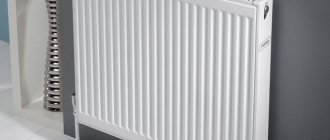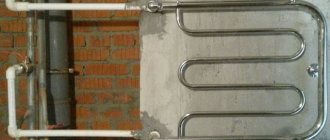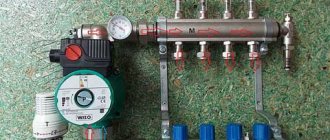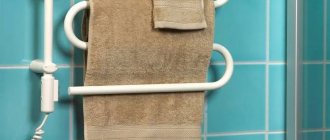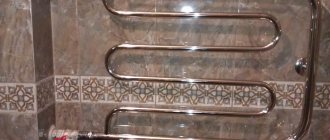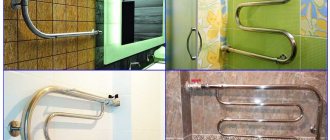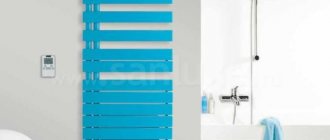It's nice to enter the bathroom when the room is dry and comfortable. A functional device – a heated towel rail – will allow you to create such conditions. This device is capable of not only drying hygiene items, but also maintaining optimal temperature conditions in the bathroom, preventing the formation of mold and dampness.
Modern manufacturers offer a wide range of devices for drying small items, which not only effectively perform the main function, but are also able to harmoniously fit into the interior of any room. Before buying such a device, you need to decide on the type of connection and heat source (water, electricity).
Water heated towel rail device
You may be interested in:Digma laptops: customer reviews, characteristics, features and types
In apartment buildings of old Soviet construction, heated towel rails are installed in the form of a coil. This design is the simplest, and is a curved pipe that is embedded in the general hot water supply system of the house.
In modern multi-apartment buildings, it is possible to connect a heated towel rail via a special outlet from the hot water supply pipe. This design solution made it possible to create drying devices of various configurations (from U-shaped to the popular “ladder”).
You will be interested in: The evolution of televisions: history of appearance, first televisions, modernization, stages of development and prospects
To connect a ladder heated towel rail with a bottom connection, you must add the following elements to the system:
- valve for bleeding air;
- special plugs;
- brackets for attaching the device to the wall;
- shut-off valves.
What designs are there?
Heated towel rails come in different shapes. When choosing them, people are often guided solely by aesthetics, which is not entirely justified. These devices work normally with good water circulation, but not all models provide such circulation. With some you have to spend a long time trying to find the right connection diagram, otherwise they simply refuse to work.
So, all heated towel rails can be divided into four groups:
- U-shaped or U-shaped. The simplest models, basic connection (lateral). Ideally, when replacing the old one, you find a model with the same center distance. Then, if you're lucky, you won't even have to redo the bends.
- Ladder. Modern designs with a certain number of crossbars. Also a good option from a hydraulic point of view. The connection can be bottom, side or diagonal. But it is not chosen arbitrarily, but according to a set of conditions (where the supply comes from, location relative to the riser).
- Snake. Another classic model with side connection. Installing a heated towel rail of this type, as a rule, does not present any problems.
- Complex shape. There are very unusual heated towel rails. They can even be an interior decoration, but their proper connection is a problem. As a rule, consultation with a competent specialist, a plumber who is well versed in hydraulics, is required. As you understand, finding one is not an easy task.
It often happens that after installing a heated towel rail it simply does not work. If the error is serious, the riser to which it is connected also stops working. Therefore, it is necessary to know and follow the connection rules.
Types of heated towel rails
Modern manufacturers offer consumers equipment for drying small items of three modifications, which are divided among themselves depending on the heating source:
- Water drying devices are the most common equipment, since the heat source is public hot water pipes. It is not difficult to install or replace such systems yourself. The “ladder” heated towel rail with a bottom connection or any other does not heat only during periods of centralized repair and maintenance work.
- Electrical devices are capable of heating the bathroom at any time, regardless of the availability of hot water. Such equipment contains its own internal environment, which is brought to a certain temperature by an electric heating element. The convenience of this model is that it can be installed anywhere as long as there is an electrical outlet.
- Recently, combined drying devices have become popular, which contain all the advantages of water and electric devices.
With or without bypass
Let's start with what a bypass is. This is a jumper between the input and output of the device, which ensures water circulation when the device fails or is turned off.
The jumper between the input and output of the heated towel rail is the bypass
If the circuit has a bypass, shut-off ball valves can be installed at the inlet and outlet of the device. This is convenient - you can turn it off if necessary (during repair or replacement) and not block the entire riser.
If there is no such jumper, no taps can be installed. In this case, the heated towel rail is part of the riser; by closing the taps, you completely shut off the riser.
When connected without bypass, no taps
The bypass can be direct (as in the first photo in the chapter) or offset (in the photo below). An offset jumper is installed at the top supply of coolant for better performance (circulation improves). With bottom feed, the offset only gets in the way. If you don't know where the water is coming from, it's better to do a direct bypass.
Offset bypass with upper coolant supply improves circulation
Bypasses (straight or offset) are also made narrower. Tapering, as well as displacement, improves circulation, but only in the case of top feed. The narrowing is made with a pipe that is one step smaller than the main one (if the riser is inch, the bottleneck is made 3/4″). You can't do less. The insert size is at least 10 cm.
Once again: an offset and/or narrowed bypass only works with top water supply. At the bottom, it interferes with circulation. If you are not sure, make the bypass straight and untapered.
It is strictly forbidden to install taps on the bypass. Each tap is a loss of pressure, which means it worsens the circulation of the entire riser, the water flows no longer so hot. For all neighbors above or below (depending on the direction of supply), the pressure deteriorates noticeably. Sometimes it also falls on the owner of the bypass with the tap. In addition, this is an absolutely unnecessary detail that only causes harm, and no noticeable improvement in circulation in the heated towel rail is observed. Well, and besides, this is a violation of SNiP 01/31/2003 (clause 10.6) - interference with public communications, for which a (considerable) fine may be issued.
Basic connection types
You may be interested in: 15AC 408: description, technical characteristics, features of operation and repair of the speaker system
In foreign countries, heated towel rails are most often connected to the residential heating system. Domestic manufacturers of plumbing equipment recommend installing drying equipment in the hot water supply system. It is for this connection that many device models are developed.
The following types of equipment connection are distinguished:
Diagonal connection for heated towel rail
This type of equipment connection is characterized by the supply of coolant to the upper part of the device, and the cooled water is discharged from below. The diagonal connection ensures efficient fluid circulation, so there is no need to bleed air from the system during operation. Good water circulation is achieved due to an undisplaced and not narrowed bypass.
The use of a diagonal connection for a heated towel rail is considered the most effective for large-capacity appliances, especially “ladder” models, since all heat conductors are involved in the working process.
What designs are there?
Heated towel rails come in different shapes. When choosing them, people are often guided solely by aesthetics, which is not entirely justified. These devices work normally with good water circulation, but not all models provide such circulation. With some you have to spend a long time trying to find the right connection diagram, otherwise they simply refuse to work.
So, all heated towel rails can be divided into four groups:
- U-shaped or U-shaped. The simplest models, basic connection (lateral). Ideally, when replacing the old one, you find a model with the same center distance. Then, if you're lucky, you won't even have to redo the bends.
- Ladder. Modern designs with a certain number of crossbars. Also a good option from a hydraulic point of view. The connection can be bottom, side or diagonal. But it is not chosen arbitrarily, but according to a set of conditions (where the supply comes from, location relative to the riser).
- Snake. Another classic model with side connection. Installing a heated towel rail of this type, as a rule, does not present any problems.
- Complex shape. There are very unusual heated towel rails. They can even be an interior decoration, but their proper connection is a problem. As a rule, consultation with a competent specialist, a plumber who is well versed in hydraulics, is required. As you understand, finding one is not an easy task.
It often happens that after installing a heated towel rail it simply does not work. If the error is serious, the riser to which it is connected also stops working. Therefore, it is necessary to know and follow the connection rules.
Side connection
You will be interested in: “Soyuz 50AS-012”: description, technical characteristics, models, reviews
The principle of water supply and drainage when using a side connection is similar to the diagonal method. Most often, a heated towel rail is connected sideways in order to save useful space in the bathroom. But at the same time it is necessary to ensure reliable fastening of the entire structure.
The main advantage of using a side connection is:
- the ability to install a drying system in any direction of water;
- lack of special valves for bleeding air;
- the efficiency of the system is not affected by the speed of water movement in the riser;
- versatility of installation work.
Common Mistakes
You cannot install shut-off valves or taps on the piping (bypass). Since the coil is part of the water main, narrowing the cross-section of the jumper is allowed only in some schemes. Otherwise, the operation of the hot water system on all floors will be disrupted.
When restoring the water supply after a temporary shutdown, you need to bleed air using the Mayevsky tap, even if the coil is heated in the apartment without problems.
It is necessary to check the pressure in the water supply network . If it is below normal, you cannot install the coil at a distance from the riser. It is not recommended to use “American” ones with narrowed fittings and a union-type nut for connection. Any narrowing, turns, or bends of less than five sections of the pipe will shorten the life of the heated towel rail.
It is impossible to groove in load-bearing walls and ceilings , especially for horizontal channels, which weaken the strength of vertical fences.
Bottom connection
The most effective is to install a “ladder” heated towel rail with a bottom connection on a hot water supply system with good pressure. The process of installing equipment with a bottom connection is considered more complex than with a side or diagonal connection. This is due to the need for mandatory preparation of the connection point, and most often requires moving the pipes indoors.
The main advantages of connecting a ladder heated towel rail with a bottom connection:
- the ability to hide supply pipes under the bathroom, without punching a channel in the wall;
- the efficiency of the device does not depend on the direction of water movement in the riser.
The disadvantages of this connection method include lower operating efficiency compared to other types of water supply, as well as the need to install a special valve to bleed air from the system.
What not to do
All the above schemes work stably. As you noticed, all bends go straight, without bends in the form of an arc or rings. This is not accidental - air accumulates in all irregularities, which interferes with, and sometimes completely blocks, circulation.
This scheme doesn't work
The installation of the heated towel rail in the photo is incorrect. At least two mistakes were made:
- the bends are made narrower than the center distance of the heated towel rail;
- They are made with a metal-plastic pipe with loops.
This connection simply cannot work. Metal-plastic pipes are an excellent material, but not for connecting heated towel rails. Their fittings have a very narrow lumen, which has a bad effect on circulation. Plus, air accumulates in the loops, and the flow along the upper loop, even when supplied from above, will not flow - too much hydraulic resistance to the water must be overcome.
Unstable circuits
The following two schemes may work, but not always. At the bottom of the heated towel rail, the water stagnates and, given any difference in height, cannot rise. No one can say specifically when it will work and when it won’t. Depends on the pressure in the riser, the diameter of the pipes and the design of the dryer itself.
Unstable connection schemes
With such a connection, even a working connection may suddenly (usually after stopping) stop working. Everything is simple: the pressure has changed, the pipes are clogged, the water from below is not “pressed”, the heated towel rail does not heat.
Another option for an unstable circuit is with a loop on top. Again, it will work under certain conditions. But sooner or later the highest point will become airy and block the circulation. The problem can be helped by installing an automatic air vent at the highest point, but if the pressure drops, it will not save you.
With loop on top
Not true at all
The photo below shows examples of what not to do. Schemes without a tap on the bypass are inoperative. What this threatens is known. In addition, after several years of use, they will stop functioning altogether. Most likely this will happen after the next shutdown - the system will become clogged with dirt. This is because the entire flow of hot water is directed through the heated towel rail. After repairs, the water carries a huge amount of dirt, which safely settles in the bends (in the lowest areas first). Within a few years everything becomes completely clogged. Fortunately, everything needs to be redone and connected correctly, but only flushing can help the fire.
Very bad idea
It is necessary to wash both the heated towel rail and the connections to it. To do this, remove the dryer and wash it in the bathroom, and wash the outlets one by one by connecting a hose to the free outlets, the other end of which is taken to the sewer. By manipulating the taps, pass a flow of hot water through one outlet, then through the other. After washing everything is put back in place. It may be possible to start the system after this.
Accessories for connecting the device
The question of which fittings for connecting a ladder heated towel rail with a bottom connection is preferable is decided depending on the location of the outlets.
If they are parallel to the wall on which the device is planned to be mounted, then straight fittings are used. In the case where the outlets are located perpendicularly, the installation of a “ladder” heated towel rail with a bottom connection is carried out using corner fittings.
You also need to pay attention to the type of thread at the junction of the device with the outlet. If the heated towel rail and outlet have an external thread, then a special fitting with two nuts is used. In the case where the device has an internal thread and the riser has an external thread, a fitting with one nut and an external thread is used.
Experts believe that the best quality is to connect a ladder heated towel rail with a bottom connection using a Rehau pipe.
How to make bends and how to change the riser
If the riser is metal and you are not going to change it, then installing a heated towel rail is possible with steel or polypropylene pipes. If you change the riser (the best option) and install polypropylene, there is no choice - PPR pipes are also used for bends. Use polypropylene for hot water, preferably reinforced with fiberglass.
Why is metal-plastic not suitable? Because its fittings have a very narrow clearance. This has a very bad effect on circulation. As a result, even 100% efficient circuits do not provide normal heating.
Installation of a heated towel rail with polypropylene pipes
A little about why to change the riser. It makes sense to do this in old houses when renovating a bathroom or bathroom (depending on where your riser is located). Firstly, the pipes are usually already old and worn out. Even welding an outlet to them can be problematic, the metal is so worn out. Secondly, modern renovations involve hidden installation of communications and you will also want to cover the riser. Hiding an old pipe and then destroying everything again a few years later... is not a good solution.
A little about how to change. You need to come to an agreement with the neighbors below and above, as well as with the housing office (DEZ, UK). With your neighbors that you will cut off their riser and install a new one on the thread. Why do they have it? Because leaving an old pipe in the ceiling is dangerous: it will collapse and leak. It will flood you or your neighbors below. Therefore, it is better to pass through the ceilings with a new pipe.
With this connection, the dryer is part of the riser and there cannot be any taps
Having agreed or not with your neighbors (their riser may already be closed), you go to the housing office and agree on the date of replacement and the time for which the riser will be turned off. The work can be done by “local” mechanics, you yourself (if you have welding qualifications) or people you hire. After the connection, the water is turned on, you check the functionality of the heated towel rail and the system as a whole. If it doesn’t start to cool within 30 minutes, it means it’s set correctly. This completes the replacement or installation of the heated towel rail.
Conditions for bottom connection
For efficient and high-quality operation of any device, it is necessary to follow certain rules for its installation. Therefore, before deciding how to connect a ladder heated towel rail with a bottom connection, you must meet the following basic conditions:
- the lowest point of the device should be located above the riser outlet;
- the level of the upper outlet must be above the connection of the heated towel rail;
- all pipes must be laid with a slope;
- the diameter of the pipes is selected to ensure good fluid circulation;
- in apartment buildings it is necessary to provide for the installation of a bypass so as not to harm neighboring apartments in the event of an emergency;
- To improve circulation, it is advisable to insulate the supply pipes with insulation.
Compliance with these conditions will significantly improve the quality of operation of the equipment used. If there is no circulation in the “ladder” heated towel rail with a bottom connection, it is necessary to check the horizontal sections of the pipes for the absence of dips or humps in which air pockets may occur.
With or without bypass
Let's start with what a bypass is. This is a jumper between the input and output of the device, which ensures water circulation when the device fails or is turned off.
The jumper between the input and output of the heated towel rail is the bypass
If the circuit has a bypass, shut-off ball valves can be installed at the inlet and outlet of the device. This is convenient - you can turn it off if necessary (during repair or replacement) and not block the entire riser.
If there is no such jumper, no taps can be installed. In this case, the heated towel rail is part of the riser; by closing the taps, you completely shut off the riser.
When connected without bypass, no taps
The bypass can be direct (as in the first photo in the chapter) or offset (in the photo below). An offset jumper is installed at the top supply of coolant for better performance (circulation improves). With bottom feed, the offset only gets in the way. If you don't know where the water is coming from, it's better to do a direct bypass.
Offset bypass with upper coolant supply improves circulation
Bypasses (straight or offset) are also made narrower. Tapering, as well as displacement, improves circulation, but only in the case of top feed. The narrowing is made with a pipe that is one step smaller than the main one (if the riser is inch, the bottleneck is made 3/4″). You can't do less. The insert size is at least 10 cm.
Once again: an offset and/or narrowed bypass only works with top water supply. At the bottom, it interferes with circulation. If you are not sure, make the bypass straight and untapered.
It is strictly forbidden to install taps on the bypass. Each tap is a loss of pressure, which means it worsens the circulation of the entire riser, the water flows no longer so hot. For all neighbors above or below (depending on the direction of supply), the pressure deteriorates noticeably. Sometimes it also falls on the owner of the bypass with the tap. In addition, this is an absolutely unnecessary detail that only causes harm, and no noticeable improvement in circulation in the heated towel rail is observed. Well, and besides, this is a violation of SNiP 01/31/2003 (clause 10.6) - interference with public communications, for which a (considerable) fine may be issued.
Device installation
The entire technological process of connecting a ladder heated towel rail with a bottom connection can be divided into several stages:
- preliminary preparation of the wall surface;
- laying and routing of pipes;
- installation of the device.
All work on the installation of the drying system must be carried out after completely shutting off the hot water riser. Moreover, in many cases, permission from the relevant public utility authorities is required.
General principle
Connecting a water heated towel rail to a hot water or heating riser is no different. All schemes are identical. The only difference is seasonality. There is almost always hot water supply (if there is one at all), heating is only available in the cold season.
The water heated towel rail is connected by separate pipes: the connection diagram for the heated towel rail in general, without considering particulars
In any case, the heated towel rail is connected through special and separate connections. It does not consume water/coolant, it only takes away some of the heat. Therefore, DHW consumption may not be counted. Heating is an issue. This is essentially a heating device. So it can be considered as a radiator.
Preliminary stage
The basis of the preliminary surface preparation stage is the marking and installation of channels for supply pipes. If you have an old heated towel rail, you must first dismantle the device. If the device was welded into the riser, it is easier to cut it off with an electric cutting tool (grinder).
Next you need to make markings. It should be taken into account that it is better to install the dryer at a height that allows an average height person to easily reach the top rung of the “ladder”. Also, to reduce heat loss, the device must be placed no further than two meters from the riser.
The next step is to hollow out the recess for the pipes. The process of wall slitting is best done with a special tool, and safety precautions must be strictly observed. Ladder water heated towel rails with a bottom connection can be installed without punching channels, for example, when pipes are laid under a bathtub.
Pipe routing
Having prepared the necessary tools and devices, you can begin laying the connecting pipes. Wiring is carried out using special fittings.
The use of modern polypropylene pipes has greatly improved the efficiency and quality of the installation stage. The pipes are laid in prepared channels in compliance with the required slope, and then connected to the point of water supply and drainage.
Next, you need to temporarily connect the heated towel rail without carrying out work on sealing the joints in order to fully ensure that the preliminary operations were carried out correctly. It should be taken into account that the couplings must protrude from the wall to the thickness of the facing material.
After the control installation, the channels are putty and the surface is tiled.
Top brands
On store shelves you can find many high-quality models of ladder dryers. They are produced by a variety of brands. Let's find out more about the best of them.
Terminus. A large manufacturer of high-quality heated towel rails. The company produces both classic and original ladders of various modifications. Each buyer can choose the ideal model for himself, which will suit him both in functionality and design. This grade of steel is characterized by ideal welding quality, as well as impeccable resistance to corrosion and oxidation.
There are many more excellent brands that produce electric, water, and universal (combined) dryers, complete with a Mayevsky faucet, various regulators and other functional components. Every buyer can make the right choice.
Installation of a heated towel rail
The device assembled according to the technical instructions is installed in the following order:
Remember that the correct bottom connection of the ladder heated towel rail is the key to efficient and high-quality operation of the device for many years. Therefore, if you do not have sufficient experience in performing plumbing work, it is better to seek help from experienced specialists.
Source
Tips for use
An electric heated towel rail, if properly selected, installed and used, is perfect not only for the bathroom, but also for other rooms.
During its operation, it is better to follow some tips.
- select the power of the device taking into account the dimensions of the room;
- During installation, be sure to use grounding and check that the electrical wiring is ready for connection;
- It is better to choose devices with a thermostat; they are more expensive, but will be more economical during operation;
- You can choose any shape of the device, the main thing is that it fits the dimensions and design of the room;
- during operation, you need to ensure that water does not get on the socket;
- check the tightness and insulation of the wire as often as possible if the heated towel rail is connected in an open way;
- the humidity level of the room must be within normal limits, otherwise there may be a risk of short circuit;
- The electric heated towel rail should not be placed near flammable objects.
If a situation arises when the heated towel rail does not heat, it is possible that the heating element is broken. For an accurate diagnosis, it is better to contact a specialist.
Most users respond well to electric heated towel rails. Some note the ease of installation, as well as the ability to move them around the house. Others like the fact that the device is convenient to use at any time. Also, many argue that these devices are really economical and do not consume a lot of electricity, especially those equipped with thermostats and electronics.
Today technology does not stand still. If previously apartment owners only had access to water heated towel rails, which did not have a particular variety of models, today everyone can treat themselves to such an innovation as an electrical device. Now its shape is not limited to a snake or a three-step ladder. You can choose any shape and size for yourself. To save energy, such heated towel rails are equipped with additional functions - thermostats and temperature sensors.
Making the right choice, as it turns out, is not so easy. Buying the first model you like would not be the best option. It is necessary to comprehensively study all the characteristics of such devices and take into account all the nuances - from power and material of manufacture to shape and size. And since modern manufacturers care about consumers, it has become quite possible to buy a high-quality and durable electric heated towel rail. Such a device will become indispensable in the bathroom not only for drying towels and linen, but also for maintaining a comfortable temperature and avoiding the development of pathogenic fungi and microbes.
See the following video about the advantages of electric heated towel rails.

